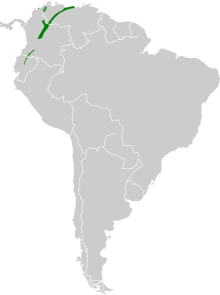Red-tailed sword wings
| Red-tailed sword wings | ||||||||||
|---|---|---|---|---|---|---|---|---|---|---|

Red-tailed sword wings |
||||||||||
| Systematics | ||||||||||
|
||||||||||
| Scientific name | ||||||||||
| Campylopterus falcatus | ||||||||||
| ( Swainson , 1821) |
The red-tailed rapier wing ( Campylopterus falcatus ) is a species of bird in the hummingbird family (Trochilidae) that is found in Colombia , Venezuela , and Ecuador . The IUCN assesses the population as Least Concern . The species is considered to be monotypical .
features
The red-tailed epee wing reaches a body length of about 11.5 to 13 cm with a weight of about 6.4 to 8 g. It can easily be confused with the violet- breasted hummingbird ( Sternoclyta cyanopectus ), the red-brown color on the tail is missing. It differs from the violet-forehead brilliant hummingbird ( Heliodoxa leadbeateri ) by a longer and more curved beak. The female can be confused with the red-tailed shadow hummingbird ( Glaucis hirsutus ) at lower altitudes , but it differs through the grayish underside and the white spot behind the eye. the male of the red-tailed sword wing has a black curved bill. The top glitters green, the top of the head is more bluish. The throat and chest glisten dark purple-blue with a bluish shimmer. The belly is green. The shafts of the outer three hand wings are thicker and flattened. The tail feathers are maroon, the central tail feathers have wide bronze green tips. The female resembles the male and also has a white spot behind the eye. The throat glitters bluish, the rest of the underside is gray throughout. The flanks have green flanks. The tail is very similar to that of the males, but the central control feathers are often more green in color. Fledglings are very similar to adult females.
Behavior and nutrition
The red-tailed sword wing gets its nectar and a. of flowering heather , heliconias , hibiscus and other plants. He catches arthropods in flight or collects them from leaves. As a trapliner, it flies regularly in rapid succession to very specific, scattered flowers in the undergrowth and the central strata of the forest. But it can also happen that he guards inflorescences or visits the treetops of flowering trees such as coral trees . He occasionally drinks water from the cover leaves of heliconia.
Vocalizations
The male red-tailed epee wing sings sitting on relatively open branches in the middle strata. Usually he gives a wide, chattering chik, it, chik, it splek, chat, sit, chik, sit, chik, it, chik, it ... in many variations. So the pattern can also sound clearer like swip, tsit, tsuet, tsit ... with the first three tones increasing. Simple pik-check sounds uttered monotonously are also part of his repertoire. Each variant of his singing can last several minutes. Occasionally the song is reminiscent of that of the great violet- eared hummingbird ( Colibri coruscans ).
Brood
The breeding season of the red-tailed rapier wing is in June in the mountains of the Sierra de Perijá in Colombia and Venezuela. In Aragua it probably breeds in October. Otherwise, little is known about its breeding biology.
distribution and habitat
The red-tailed sword wing prefers high and low mountainous semi-deciduous forests, flowering gardens, the edges of plantations and sub- páramo at altitudes between 900 and 3000 meters. In Venezuela he is mostly on the move at 1200 to 2300 meters. In northern Colombia it has been spotted down to altitudes around 450 meters.
migration
The red-tailed sword wing is probably a resident bird , but there is a lack of reliable data on migratory behavior.
Etymology and history of research
The first description of the Red-wing sword was made in 1821 by William Swainson under the scientific name Trochilus falcatus . The type specimen was in the collection of William Bullock . In 1827 Swainson introduced the new genus Campylopterus . This word is derived from the Greek »kampylos καμπύλος « for »curved, curved« and »-pteros, pteron πτερο « for »-fluted, wing«. The species name "falcatus" is Latin for "sickle-shaped" from "falx, falcis" for "sickle".
literature
- Carlos Sánchez Osés, Guy Maxwell Kirwan in: Josep del Hoyo, Andrew Elliott, Jordi Sargatal , David Andrew Christie , Eduardo de Juana: Lazuline Sabrewing (Campylopterus falcatus) In: Handbook of the Birds of the World Alive . Lynx Edicions, Barcelona.
- James A. Jobling: Helm Dictionary of Scientific Bird Names . Christopher Helm, London 2010, ISBN 978-1-4081-2501-4 .
- William Swainson: Zoological illustrations, or, Original figures and descriptions of new, rare, or interesting animals: selected chiefly from the classes of ornithology, entomology, and conchology, and arranged on the principles of Cuvier and other modern zoologists . tape 2 . Printed by R. and A. Taylor for Baldwin, Cradock, and Joy; and W. Wood, London 1821 ( biodiversitylibrary.org - 1821-1822).
- William Swainson: On several Groups and Forms in Ornithology, no hitherto defined . In: The Zoological journal . tape 3 , no. 11 , 1827, pp. 343-363 ( biodiversitylibrary.org ).
Web links
- Campylopterus falcatus inthe IUCN Red List of Threatened Species 2019.2. Listed by: BirdLife International, 2016. Retrieved September 2, 2019.
- BirdLife International: Species Factsheet - Lazuline Sabrewing ( Campylopterus falcatus ) . Retrieved September 2, 2019.
- Videos, photos and sound recordings of Lazuline Sabrewing (Campylopterus falcatus) in the Internet Bird Collection
- Red-tailed rapier wings ( Campylopterus falcatus ) at Avibase; accessed on September 2, 2019.
- Campylopterus falcatus in the Integrated Taxonomic Information System (ITIS). Retrieved September 2, 2019.
- xeno-canto: Sound recordings - Red-tailed sword wings ( Campylopterus falcatus )
- Lazuline Sabrewing (Campylopterus falcatus) in the Encyclopedia of Life . Retrieved September 2, 2019.
